Abstract
Introduction:
Attractive people do not seem to consistently possess such ideal characteristics or share common features. There is no general consensus about the linear and angular characteristics that discriminate between attractive and normal persons.
Aim:
This study determines how young Asian women considered to be attractive differ in their twodimensional facial characteristics from normal women of the same age and race.
Materials and Methods:
Frontal and lateral photographs of 70 young Asian females were taken under standardized setting and were given to 15 judges who did not know the subjects in the study, to rate the attractiveness of each photograph. All 70 photographs were arranged in descending order of their total score by all the judges and were classified into three groups. Three angular, 8 linear measurements, and 3 ratios were compared between these groups.
Results:
This study showed that most attractive group had least convex face, larger forehead, and wider faces. Conversely, the middle facial height was larger in the least attractive group. The ratio of middle third to total face of the most attractive group is higher than the average attractive ones. The ratio of lower third to total face of the most attractive group is lower than the average attractive ones.
Keywords: Attractiveness, morphometric analysis, two-dimensional morphometric analysis
INTRODUCTION
Artists, surgeons, orthodontists, and even lay people have often searched for a quantitative definition of human beauty. Facial appearance is clearly important to an individual's social well-being. The classic esthetic criteria have been defined since the Greek Golden Age. The scientific study of facial attractiveness has come into its own in the past 30 years, with more than 2000 articles being published dealing with the subjects since 1970.
There is good evidence that individuals with facial deformity suffer from a variety of psychosocial problems. It has been found that the child's attractiveness was significantly and positively associated with teacher's expectations about how intelligent the child was, how interested in education his parents were, how far he/she was likely to progress in school, and how popular he/she would be with his/her peers.[1] The face reveals comprehensive information about a person. One thing that the face can tell us is the sex of a person, although there are only two sexes, many degrees of femininity and masculinity which may express many of the hidden meaning of the behavior of an individual.[2] It is also being proved that the facial appearance affects the ability of a person to find partners of the opposite sex.[3]
Beautiful persons neither seem to consistently possess ideal characteristic features nor they are often consistently recognized as such, their faces do not necessarily share common features and there is no general consensus about the linear and angular characteristics that should be discriminated between beautiful and normal persons. It is thus been stated that the only scientific means of measuring a subjective quality such as facial beauty is through a panel of judges. Use of standardized photograph might provide the basis of judging or clinical audit of treatment aimed at improving facial esthetics.[4]
The notion that accurate measurements could also be obtained from standardized photographs was proposed in the 1940s.[5] Tanner and Weiner examined the reliability of the technique and concluded that although photogrammetry of the trunk and limbs was just as accurate as direct body measurements, facial measurements were not as reliable. They explained that the posing errors were of greater magnitude than the increments of growth because, in their study, no steps were taken to accurately position the head. They thought that standardized positioning of the face would have significantly improved the reliability of the measurements.[6]
The aim of this investigation was to determine how young Asian females considered to be attractive differ in their two-dimensional (2D) facial characteristics from their peer groups of the same age and race when comparison is done in standardized photographs.
MATERIALS AND METHODS
This study got clearance from the Ethical Committee of the Institution where it was conducted and this study complies with the Helsinki Declaration. Seventy-five Asian females between ages of 20 and 25 were included in this study, excluding those who are undergoing orthodontic treatment and who had congenital deformities. Standardized frontal and lateral photographs of all subjects were taken [Figure 1]. All the photographs were given for analysis to 15 judges who are engineers of the age group 30–35 years, from different branches (such as computer science, civil, and electronics) of a nearby engineering college, who did not know the subjects in the study, to rate attractiveness of each photograph in a scale of 1–10 Table 1. All 70 photographs that were rated, were arranged in descending order of their grand total score given by all the judges. The subjects were categorized into three groups: A, B, and C [Table 2].
Figure 1.
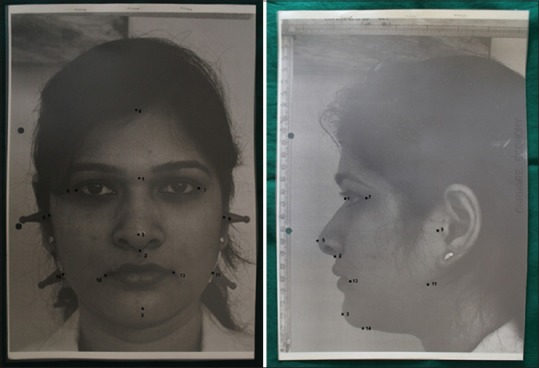
All the points are being marked
Table 1.
Scores of all candidates given by judgment panel
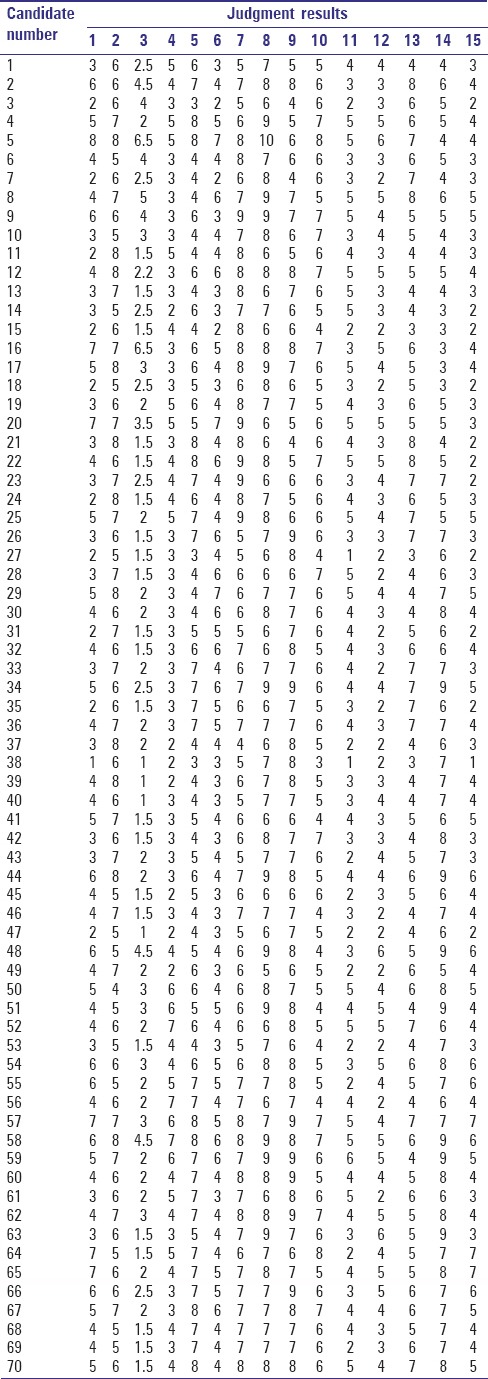
Table 2.
Scores of all candidates given by judgment panel for Group A, Group B, and Group C
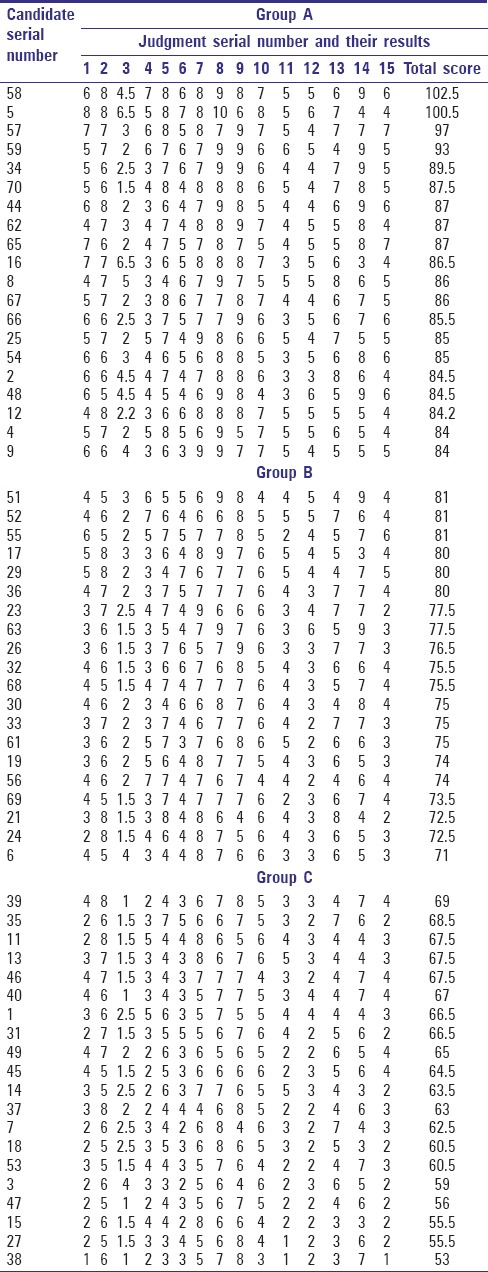
Group A represents the first 20 candidates who got the highest score, and it represents the most attractive. Group B represents 20 candidates with average overall score who represents the average candidates. Group C represents 20 candidates who got the least overall score and represents the least attractive group. Three angular and 8 linear measurements, and 3 ratios were compared between these groups [Figure 2] [Tables 3 and 4].
Figure 2.
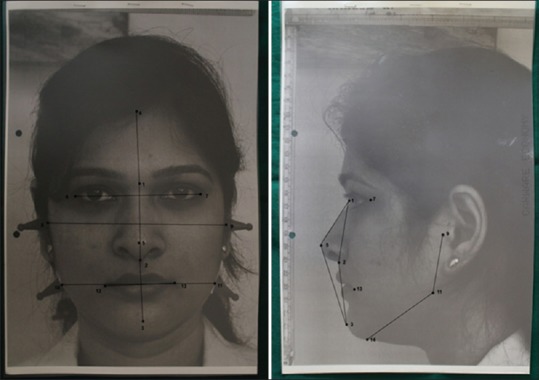
Tracings on the photograph are being done
Table 3.
Cephalometric points used in the study
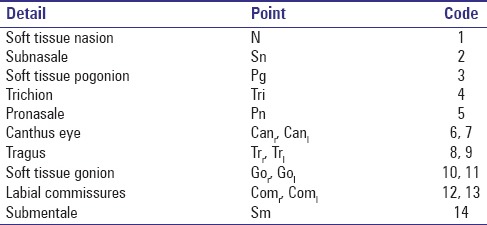
Table 4.
Measurements done
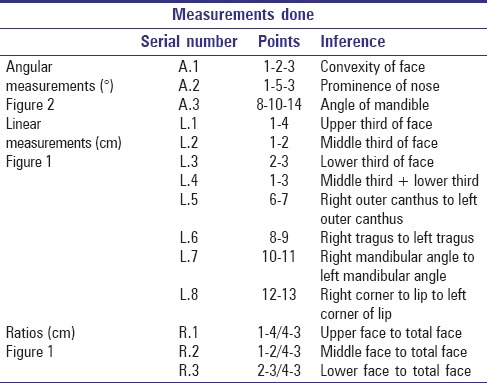
RESULTS
Following the study, we found that on an average, the most attractive group, Group A (159.75 ± 4.18) had less convex faces (A.1, points 1-2-3) than the average girls (Group B) (163.2 ± 6.2) and still lower than the least attractive group, Group C (166.2 ± 5.23) [Table 5]. The mean value for the forehead (upper face) height of the most attractive group, Group A (8.1 ± 0.16) was significantly larger than the corresponding value of the average attractive Group B (5.08 ± 0.17) and the least attractive Group C (4.08 ± 0.17) when expressed as a linear measurement of L.1 [Table 6]. Conversely, the middle facial height (L.2) was larger in the least attractive Group C (9.28 ± 0.36) than in average attractive Group B (7.14 ± 0.18) and in the most attractive Group A (3.99 ± 0.35) [Table 6]. The most attractive girls, Group A had wider faces, both L.6 (middle third) and L.7 (lower third), than the average attractive girls, Group B.
Table 5.
Comparison of angles of three groups of subjects studied

Table 6.
Comparison of linear measurements of 3 groups of subjects studied
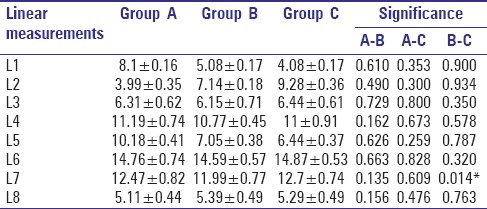
The ratio of middle third to total face of the most attractive group, Group A (0.27 ± 0.03) is higher than the average attractive ones, Group B (0.26 ± 0.04) [Table 7]. The ratio of lower third to total face of the most attractive group, Group A (0.35 ± 0.03) is lower than the average attractive ones, Group B (0.36 ± 0.12) [Table 7].
Table 7.
Comparison of ratios of three groups of subjects studied

DISCUSSION
The individuality of the human face is an important phenomenon in one's life. No part of our anatomy provides more information such as the face. Minor alterations in the size, shape, position, and proportion of our face result in major perceptible differences and subtle differences between two people are instantly recognizable. Measurements of the human face have been performed since ancient times and many measurements defined then can still be found in modern clinical anthropometry.[7]
Facial attractiveness is a more objective quality and has a more significant impact on people's lives than people who believe the maxims that “beauty is in the eye of the beholder,” “a book should not be judged by its cover,” and “beauty is only skin deep” would care to admit.
Human attractiveness, particularly facial attractiveness, evolved because of mate preference for healthy and fertile mates. Facial attractiveness in humans has evolved as an important marker for both overall phenotypic and genetic quality. There are clues that human beings subconsciously use only 150ms to judge facial attractiveness[8] are closeness of fit to the human facial prototype (averageness), sexual dimorphism secondary to sex hormones, youthfulness and neoteny of the face, and fluctuating asymmetry. Positron emission tomographic scans showed an increase regional cerebral blood flow when assessing facial attractiveness in two left frontal regions. All of these cues are used simultaneously and most likely in an order of significance according to the listing given. Therefore, facial attractiveness is attributable to both configurational (prototypicality, symmetry, and youthfulness) and featural cues (sexually dimorphic features). When planning facial cosmetic, plastic, or reconstructive surgery, the surgeon should take into account these findings. Principally, the aim should be to produce a face that is close to the prototype associated with the population being operated on.
One must also consider the findings regarding sexual dimorphism while discussing about the attractiveness and beauty of face. The evidence unequivocally shows that powerful female sexually dimorphic features are significantly more attractive to male individuals.
Youthfulness in faces may be achieved by aiming toward a prototype created using youthful faces (e.g. phi mask) and also by maximizing sexually dimorphic cues (which correlate strongly with youth and fertility cues, particularly in women). Neotenous cues promote caring behavior in perceivers and, for women, are similar to the female sexually dimorphic cues (possibly adding rhinoplasty for a smaller nose and skin therapy to achieve a more youthful and paler texture of the skin).
The 2D cutaneous facial characteristics of attractive young women selected only on the basis of their soft-tissue facial attractiveness on a profile photograph were significantly different from the characteristics of young women selected according to criteria of dentofacial normality. The differences involved the absolute values of several angular measurements, distances, volumes, and their reciprocal ratios.
When craniofacial growth patterns or anatomic variations are described, conventional direct anthropometry currently is considered the gold standard for in vivo assessments. The method is simple, is low in cost, and does not require complex instrumentation but requires very well-trained and experienced examiners, and it is very demanding for both the clinician and the patient.[9] A number of relatively noninvasive methods for three-dimensional imaging have been developed over past decades to obtain facial anthropometric data. Unfortunately, the cost and complexity of these methods often limit their use to research facilities. In the current study, a simple, low-cost, noninvasive 2D method for facial surface measurements was developed and tested. It eliminates the need for direct contact with the subject, thereby avoiding displacement/deformation of soft tissues. The investigator can use coordinates of the landmarks for off-line calculation of distances and angles. Anyone can evaluate a new measurement from the same landmarks without new data collection.
The usefulness of the patients’ photographs is limited unless the prints are of standardized view and size. In the current study, we developed a new protocol/system for the standardization of the subjects’ photographs, so that every print made were life-size (1:1 magnification).
The present investigation was to determine how young women considered to be beautiful differ in their 2D facial characteristics from normal women of the same age and race. The data regarding symmetry and youthfulness are already basic tenets of plastic surgery. Obviously, surgeons should strive to attain as much symmetry as possible between the two halves of the face. However, in the rare instances of reconstructive surgery in which material for reconstruction is limited (e.g., skin, bone, hair, and/or fat grafts), data show that the right side of the face (particularly in women) is more often used in making attractiveness judgments and should be prioritized. The glabella-subnasale: Subnasale-menton distance ratio should be 1:1 in well-balanced faces.[10,11] This ratio was not measured in this investigation because glabella and the menton cannot be unequivocally identified directly on the skin of the subject, however can approximate it.
Following the study, we found that on an average, the facial attractiveness increases with decrease in convexity of faces. The mean value for the forehead (upper face) height of the most attractive Group A was significantly larger than the corresponding value of the average and least attractive groups B and C, whereas the middle facial height was larger in the least attractive Group C. The most attractive girls had wider faces, both in middle and in lower third. The ratio of middle third to total face was higher in the attractive group. The most attractive Group A had a lower ratio of lower third to total face, where the ratio increased as the attractiveness decreases.
Our study also supports the fact that attractiveness and good looks largely depend on a cultural, ethnic background of the observer as we found a variation in the scores for same subject by different judges. Especially in our Group A attractive sample, these standards of beauty are not absolute and depend on the cultural and ethnic background of the country at a particular time. They may change with time, thus making the present attractive women seen less attractive in the future. Independent of functional considerations, surgeons and orthodontists should not adhere too strictly to the current fashion. Their patients should look nice longer than the ephemeral life of the consumers’ fashion.
About statistics
Descriptive and inferential statistical analysis has been carried out in the present study. Analysis of variance has been used to find the significance of study parameters between three or more groups of subjects; Post-hoc Tukey test has been used to find the pairwise significance.
Declaration of patient consent
The authors certify that they have obtained all appropriate patient consent forms. In the form the patient(s) has/have given his/her/their consent for his/her/their images and other clinical information to be reported in the journal. The patients understand that their names and initials will not be published and due efforts will be made to conceal their identity, but anonymity cannot be guaranteed.
Financial support and sponsorship
Nil.
Conflicts of interest
There are no conflicts of interest.
REFERENCES
- 1.Shaw WC, Humphreys S. Influence of children's dentofacial appearance on teacher expectations. Community Dent Oral Epidemiol. 1982;10:313–9. doi: 10.1111/j.1600-0528.1982.tb00401.x. [DOI] [PubMed] [Google Scholar]
- 2.Markovic MD. At the crossroads of oral facial genetics. Eur J Orthod. 1992;14:469–81. doi: 10.1093/ejo/14.6.469. [DOI] [PubMed] [Google Scholar]
- 3.Grammer K, Thornhill R. Human (Homo sapiens) facial attractiveness and sexual selection: The role of symmetry and averageness. J Comp Psychol. 1994;108:233–42. doi: 10.1037/0735-7036.108.3.233. [DOI] [PubMed] [Google Scholar]
- 4.Roberts-Harry DP, Hathorn IS, Stephens CD. The ranking of facial attractiveness. Eur J Orthod. 1992;14:483–8. doi: 10.1093/ejo/14.6.483. [DOI] [PubMed] [Google Scholar]
- 5.Sheldon WH. The Varieties of Human Physique. New York: Harpers; 1940. [Google Scholar]
- 6.Tanner JM, Weiner JS. The reliability of the photogrammetric method of anthropometry, with a description of a miniature camera technique. Am J Phys Anthropol. 1949;7:145–86. doi: 10.1002/ajpa.1330070203. [DOI] [PubMed] [Google Scholar]
- 7.Abdullah N, Naing L, Ismail NM, Ismail AR. A cross-sectional study of soft tissue facial morphometry in children and adolescents. Malays J Med Sci. 2006;13:25–9. [PMC free article] [PubMed] [Google Scholar]
- 8.Bashour M. History and current concepts in the analysis of facial attractiveness. Plast Reconstr Surg. 2006;118:741–56. doi: 10.1097/01.prs.0000233051.61512.65. [DOI] [PubMed] [Google Scholar]
- 9.de Menezes M, Rosati R, Allievi C, Sforza C. A photographic system for the three-dimensional study of facial morphology. Angle Orthod. 2009;79:1070–7. doi: 10.2319/111008-570. [DOI] [PubMed] [Google Scholar]
- 10.Ferrario VF, Sforza C, Mianí A, Poggio CE, Schmitz J. Harmonic analysis and clustering of facial profiles. Int J Adult Orthodon Orthognath Surg. 1992;7:171–9. [PubMed] [Google Scholar]
- 11.Scheideman GB, Bell WH, Legan HL, Finn RA, Reisch JS. Cephalometric analysis of dentofacial normals. Am J Orthod. 1980;78:404–20. doi: 10.1016/0002-9416(80)90021-4. [DOI] [PubMed] [Google Scholar]


